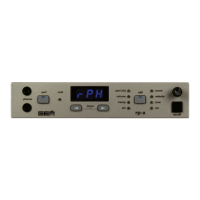
Do you have a question about the GEM rp-x and is the answer not in the manual?
Covers general cautions, alarm symbols, and important notes regarding product safety.
Details essential safety guidelines for operating the instrument, including electrical and environmental considerations.
Introduces the GEM rp-x Expander, highlighting its sound quality and operational interface.
Describes the function of each button, knob, and display on the front panel of the rp-x.
Details the function of all rear panel connectors including power, USB, MIDI, pedals, input, and output.
Instructions for connecting the power adapter and turning on the rp-x unit.
Guidance on connecting the rp-x to external speaker systems or mixers for sound output.
How to connect and use the rp-x with various MIDI master keyboards and controllers.
Instructions for connecting expression/sustain pedals and external audio input sources.
Explains how to connect the rp-x to a PC via MIDI or USB for editing and sequencing operations.
How to power on the unit and play the internal demonstration songs to evaluate sound quality.
Details the default operating mode for playing and performing, including memory storage.
Methods for selecting internal performances using the unit's buttons or via MIDI Program Change messages.
How to edit factory presets and store up to 99 custom performance settings.
How to choose specific MIDI channels (parts) to edit within a performance.
How to adjust sound selection and volume levels for individual parts within a performance.
Adjusting velocity sensitivity, pitch transpose, and fine-tuning for selected parts.
How to control the send level for effects like Chorus, Phaser, or Delay on selected parts.
How to control the reverb send level for individual parts.
Using the 'ALL' mode to simultaneously edit parameters like Volume, Velocity, Transpose, Tune, EFX, and Reverb across all parts.
Procedures for storing modified performances either in the same memory slot or a different one.
How to exit the save operation and how to copy performance data to other available locations.
Configuring the global MIDI channel and assigning unique identification numbers for MIDI networks.
Guide on how to reset the instrument to its original factory configuration and programmed setup.
How to transmit performance data to an external MIDI device for backup and archiving.
A comprehensive reference of all 50 internal sounds and their program change assignments.
A comprehensive reference of all 99 performances, including their modes and relevant notes.
Explanation of the core DRAKE DSP technology and various physical modeling techniques used in the rp-x.
Detailed list of the rp-x's technical specifications including polyphony, sounds, memory, and dimensions.
Details the MIDI implementation, including transmitted and recognized messages and control parameters.